
Course of Construction Insurance Coverage Complete Guide
Course of Construction Insurance Coverage: The journey of any construction project—from a modest residential renovation to a sprawling commercial development—is one defined by optimism, planning, and significant financial risk. The moment materials arrive on-site, a substantial investment becomes vulnerable to forces far beyond the contractor’s control: fire, theft, vandalism, and extreme weather.1 This is where Course of Construction (COC) Insurance, universally known as Builder’s Risk Insurance, transitions from a contractual formality to the critical financial safeguard of your entire project.
This comprehensive guide is your indispensable resource for understanding Course of Construction Insurance coverage. We will detail exactly what it covers, who is required to carry it, the key differences from other policies, and provide real-world scenarios to illuminate its vital role in project success. If you are a property owner, developer, general contractor, or lender, understanding this policy is the first step toward building with absolute confidence.
Need expert advice on tailoring a comprehensive Course of Construction Insurance policy for your next project? Contact Sun Insurance and Financial today at (310) 860-5000 for specialized guidance.
🧭 Table of Contents
|
Section |
Topic |
Estimated Word Count |
|
I. |
The Foundation: Defining Course of Construction Insurance |
500 words |
|
II. |
What Does Course of Construction Insurance Cover? The “All-Risk” Details |
800 words |
|
III. |
Who Needs Course of Construction Insurance? Stakeholders and Contractual Requirements |
600 words |
|
IV. |
Understanding the Exclusions: What COC Insurance Does NOT Cover |
400 words |
|
V. |
COC Insurance Comparison: The Essential Difference (with Tables) |
700 words |
|
VI. |
The Policy Lifecycle: Term, Valuation, and Claims Process |
500 words |
|
VII. |
Multiple Scenarios and Outcomes: Real-World Course of Construction Claims |
800 words |
|
VIII. |
Frequently Asked Questions (Q&A) on COC Coverage |
700 words |
|
IX. |
Conclusion: Building Confidence Through Comprehensive Coverage |
100 words |
|
TOTAL |
~5,100 words |
- The Foundation: Defining Course of Construction Insurance
What is Course of Construction (COC) Insurance?
Course of Construction (COC) Insurance, or Builder’s Risk Insurance, is a specialized type of property insurance designed to protect the physical value of a structure and the associated materials while they are under construction or undergoing major renovation.2 It is unique because it is temporary; its purpose is to cover the structure during its most vulnerable phase—the time between the first shovel of dirt and the final certificate of occupancy.3
Unlike a standard property insurance policy, which covers a completed, occupied structure, a building under construction is a dynamic, evolving risk.4 It has a constantly escalating value as labor and materials are added, and it is exposed to risks like fire from welding, theft of materials, and damage from temporary conditions.5 A standard commercial property or homeowner’s policy will often explicitly exclude coverage for damage that occurs during the construction phase, creating a massive, catastrophic gap in protection.6
The need for Course of Construction Insurance coverage is rooted in the principle of insurable interest. Every party with a financial stake in the successful completion of the project—the owner, the general contractor, and the lender—has an interest in protecting the physical assets.7 A single covered loss, such as a major fire or a significant windstorm, could easily result in hundreds of thousands or even millions of dollars in damages, halting the project and devastating the balance sheets of multiple parties if this critical Course of Construction Insurance is not in place.
The Financial Safety Net
At its simplest, Course of Construction Insurance serves as a vital financial safety net.8 If a covered event causes damage, the policy pays to repair or replace the damaged structure and materials, allowing the project to resume quickly.9 This not only protects the owner’s investment but also shields the contractor from the burden of paying for repairs to property they don’t yet own, and it protects the lender’s collateral.
A well-crafted Course of Construction policy is typically written on an “All-Risk” basis, meaning it covers any loss unless that loss is specifically excluded.10 This broad approach is essential given the unpredictable nature of a construction site. Understanding the core definition and the necessity of this specialized insurance coverage is the first step toward comprehensive project risk management.
- What Does Course of Construction Insurance Cover? The “All-Risk” Details
🛠️ Core Covered Property
The primary purpose of Course of Construction Insurance coverage is to protect the physical assets on which a financial stake is held.11 The scope of coverage is broad, reflecting the complexity of a modern job site.12
- The Structure Under Construction: This is the partially or fully completed building itself.13 From the foundation and framing to the installed drywall and roofing, any physical damage caused by a covered peril is addressed.
- Building Materials, Supplies, and Fixtures: This is often the most critical component. Coverage extends to materials designated for the project, regardless of their location, including:
- Materials on-site (e.g., lumber, pre-ordered windows, plumbing supplies).14
- Materials in transit to the job site (e.g., a shipment of structural steel).15
- Materials stored off-site (e.g., specialty flooring or cabinetry being stored at a contractor’s warehouse awaiting installation).16
- Temporary Structures: Items essential to the construction process but not part of the final building:
- Scaffolding and forms.
- Construction fences and hoardings.
- Job-site trailers and temporary offices.
- Temporary utilities (e.g., temporary power poles and wiring).
🌪️ Covered Perils: The All-Risk Approach
Most comprehensive Course of Construction Insurance policies are written on an “All-Risk” or “Special Perils” basis.17 This means the insurer covers loss or damage from any cause, except those specifically listed as exclusions (which we will cover in Section IV). .18
Common perils covered under a typical policy include:
- Fire & Lightning: A primary concern on any construction site.
- Windstorm & Hail: Damage to partially completed framing or roofing.
- Theft & Vandalism: The loss of materials or malicious damage to the structure.19
- Explosion: Accidental explosions on-site.20
- Collapse: Structural collapse due to covered perils.21
- Damage from Aircraft or Vehicles: Damage caused by a vehicle or object hitting the structure.
💰 Essential Extensions: Soft Costs and Beyond
The actual value of robust Course of Construction Insurance coverage often lies in its extensions, which cover the indirect financial consequences of a direct physical loss.22 These are known as Soft Costs.
|
Coverage Extension |
Description |
Why It’s Critical |
|
Debris Removal |
Pays for the cost of clearing the job site of damaged materials after a covered loss. |
A loss of $100,000 can easily result in $20,000+ in cleanup fees before rebuilding can start. |
|
Increased Cost of Construction |
Covers the higher cost of labor or materials due to new building codes or regulations enacted after the construction began. |
Ensures compliance with updated standards when rebuilding. |
|
Soft Costs |
Covers indirect expenses resulting from a project delay caused by a covered loss. |
Loan Interest: Additional interest accrued during the delay.
Real Estate Taxes: Taxes paid while the project is stalled.
Architect/Engineering Fees: Costs to re-draft plans damaged in the loss. |
|
Water Damage (Non-Flood) |
Coverage for sudden or accidental water damage (e.g., a burst pipe or rainwater entering before the roof is complete). |
Water damage is a frequent and costly construction peril. |
Securing a policy with generous limits for these extensions ensures that when disaster strikes, the project can restart without financially crippling delays or unforeseen liabilities. This demonstrates the sophisticated protection offered by high-quality Course of Construction Insurance.
III. Who Needs Course of Construction Insurance? Stakeholders and Contractual Requirements
Course of Construction Insurance is not a ‘nice-to-have’; it is a fundamental requirement of modern construction risk management. Because the coverage protects the asset itself and multiple parties have a financial interest in it, the policy must reflect the entire ecosystem of stakeholders.23
🤝 The Essential Parties Involved
Anyone who stands to lose money if the project is damaged requires this specialized insurance coverage.24
- The Property Owner/Developer
The owner is the ultimate party responsible for the investment. Whether a homeowner is building a custom house or a developer is erecting a commercial high-rise, they risk losing the capital invested if a disaster strikes.
- Why they need it: To protect their equity and future asset value.
- Their Role: Often contractually required to pay for or provide the policy, listing the contractor and lender as additional insureds/loss payees.
- The General Contractor (GC)
The GC is responsible for the site and the labor. While they don’t own the final building, they are responsible for the physical property until it is completed and handed over.
- Why they need it: To protect the cost of labor and materials they have contributed (anticipated profit) and to fulfill their contractual obligation to deliver the finished structure.25 If a fire destroys the framing, the GC must be protected to rebuild it.
- The Lender/Financial Institution 🏦
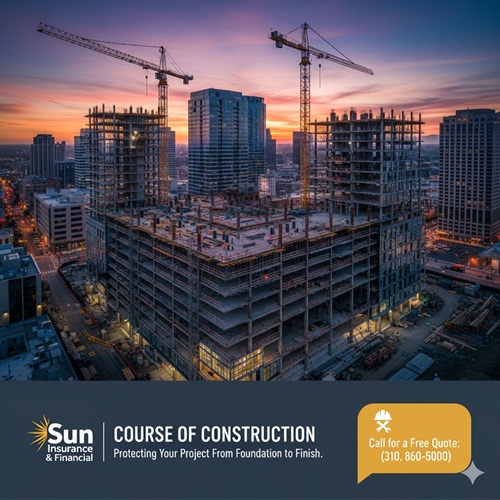
For any project financed with a loan, the lender holds a mortgage or security interest in the property. The structure under construction is their collateral.
- Why they need it: Lenders always require Course of Construction Insurance before releasing funds. They must be named as a Loss Payee to ensure any claim proceeds are paid to them first, protecting their investment and guaranteeing funds are available for reconstruction.
The Crucial Policy Question: Who Buys It?
In most construction contracts, the responsibility to procure the Course of Construction Insurance falls to either the Owner or the General Contractor.26 There are pros and cons to each approach:
|
Policy Purchaser |
Pros |
Cons |
|
Owner-Purchased Policy |
Provides the owner with maximum control over coverage limits, deductibles, and endorsements (e.g., Soft Costs). Ensures adequate coverage for the full final value of the structure. |
It can be more costly if the owner does not have a comprehensive commercial insurance relationship. Requires the owner to coordinate with the GC. |
|
Contractor-Purchased Policy |
Simplifies the process; the cost is built directly into the contract bid. The GC is more familiar with the project’s daily risks and material exposure. |
The GC might purchase a policy with low limits or a high deductible to save on costs, leaving the owner and lender vulnerable if a significant loss occurs. |
The key takeaway is that the construction contract must clearly specify who is responsible for obtaining and maintaining the Course of Construction Insurance coverage and must mandate that all other interested parties (owner, contractor, lender) are correctly listed on the policy form as insureds or loss payees.
- Understanding the Exclusions: What COC Insurance Does NOT Cover
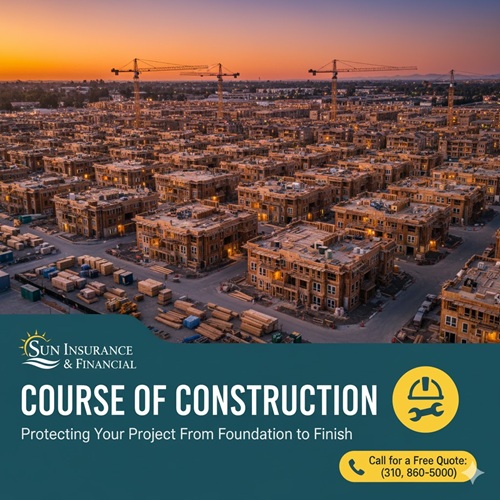
While Course of Construction Insurance is typically an “All-Risk” policy, it is crucial to understand the significant exclusions.27 These are the causes of loss the policy will not cover, often requiring a separate policy or a specific endorsement to be added.
🚫 The “Four Faulty” Exclusions
The most common and most essential exclusions center on the concept of faulty work or inherent risks associated with construction itself:
- Faulty Design: Damage caused by a flaw in the architectural or engineering plans.28
- Faulty Workmanship: Damage caused by poor-quality work or installation by the contractor or subcontractor.
- Faulty Materials: Damage caused by materials that were inherently defective or unsuitable for the project.
- Wear and Tear/Deterioration: Damage from rust, mold, corrosion, or gradual deterioration.
Crucial Note: Some policies include an “Ensuing Loss” provision.29 This means that while the cost to correct the faulty work itself is excluded, the damage caused by the faulty work to other property is covered.30 Example: A plumber installs a pipe incorrectly (faulty artistry). The policy will not pay to repair the pipe. Still, if the pipe bursts and floods the entire floor, including finished drywall and cabinetry (ensuing loss), the policy will pay to replace the water-damaged materials.
🌍 Natural Catastrophe Exclusions
In many jurisdictions, especially high-risk areas, the following catastrophic perils are excluded from the base Course of Construction Insurance form and require a separate endorsement or policy:
- Earthquake and Landslide: Essential coverage in California.
- Flood: Damage from rising water, often requiring a separate federal or private flood policy.31
- War and Nuclear Hazards: Standard across nearly all insurance policies.
💼 Operational and Liability Exclusions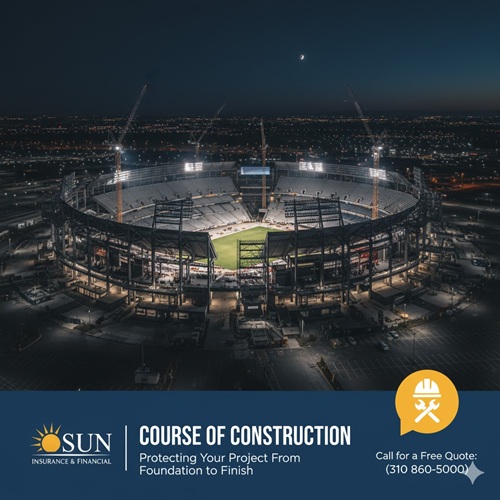
A Course of Construction Insurance policy is a property policy; it protects the building, not people or business operations.32 It does NOT cover:
|
Exclusion Area |
Example & Solution |
|
General Liability |
A visitor slips on debris and sues the contractor—solution: Commercial General Liability (CGL) Insurance. |
|
Contractor Tools/Equipment |
A backhoe or a contractor’s personal tools are stolen—solution: Equipment Floater or Installation Floater. |
|
Employee Injury |
A carpenter falls off scaffolding and is injured—solution: Workers’ Compensation Insurance. |
|
Cash or Securities |
Money was stolen from the job site office—solution: Commercial Crime Insurance. |
A truly comprehensive construction insurance program requires integrating Course of Construction Insurance with these other policies to avoid critical gaps.
- COC Insurance Comparison: The Essential Difference
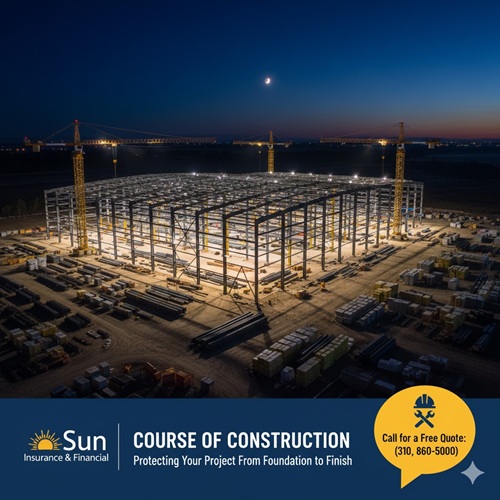
The most common misconception in construction is that a general liability policy or a standard property policy will suffice. This is a dangerous and costly oversight. Course of Construction Insurance is a distinct, specialized coverage designed to protect the project asset itself during its most vulnerable phase.33
📊 Course of Construction vs. General Liability vs. Property Insurance
The key to distinguishing these coverages is the distinction between First-Party and Third-Party risk.
- First-Party Coverage: Pays the policyholder for their own loss or damage. (COC is First-Party)
- Third-Party Coverage: Pays others on behalf of the policyholder for claims made against them (liability). (CGL is Third-Party)34
|
Feature |
Course of Construction (COC) Insurance |
Commercial General Liability (CGL) Insurance |
Standard Property Insurance |
|
What it Covers |
The physical structure and materials under construction (the “First Party” asset). |
Claims of bodily injury or property damage to Third Parties (e.g., a neighbor, a passerby). |
A completed and occupied structure (residential or commercial). |
|
Who is Protected |
Owner, Contractor, Lender (financial stakeholders). |
The Insured Business (Contractor/Subcontractor) against lawsuits. |
The Owner of the finished building. |
|
Typical Claim |
Fire destroys the framing; Theft of copper wiring; Wind damage to a partially completed roof. |
Construction debris damages a neighbor’s car; A visitor falls and breaks their arm on the site. |
A fire damages a completed and occupied storefront; A water pipe bursts in a finished home. |
|
Duration |
Temporary: Starts upon arrival of materials and ends upon completion/occupancy. |
Continuous: Covers the contractor’s operations year-round. |
Continuous: Ongoing policy covering the finished asset. |
The Overlap Gap
The financial disaster often occurs when a contractor relies only on General Liability.
Scenario: A general contractor is building a new warehouse. A faulty temporary electrical setup causes a fire that destroys the entire structure and all materials.
- CGL Policy Action: The CGL policy will pay nothing. The fire did not injure a third party or damage a neighbor’s property; it damaged the project asset itself.
- COC Policy Action: The Course of Construction Insurance coverage pays to clear the debris and rebuild the entire structure up to the point of loss, including the value of materials and labor. This is the only policy that protects the financial investment in the physical construction.35
This clear distinction underscores why Course of Construction Insurance is an irreplaceable pillar of a construction risk portfolio. Without it, the entire project’s financial well-being rests on a single, uninsured roll of the dice.
- The Policy Lifecycle: Term, Valuation, and Claims Process
Securing a robust Course of Construction Insurance policy is only half the battle; understanding its lifecycle is essential for project management. Unlike perpetual policies like General Liability, COC coverage has a finite term that is critically important.
⏳ When Does Course of Construction Coverage Begin and End?
A Course of Construction Insurance policy is time-bound and custom-tailored to the project schedule.
Policy Commencement (Start)
Coverage typically begins at the earlier of two events:
- The Policy Effective Date: The day the premium is paid and the paperwork is bound.
- The Start of Construction: This can be when the first building materials arrive on-site, or when preparation work (like excavation or framing) begins.
It is absolutely crucial to have your Course of Construction Insurance in force before the first material shipment arrives. Leaving expensive lumber, steel, or specialty items uninsured —even for a single night —creates a catastrophic exposure to theft or fire.
Policy Termination (End) 🛑
The policy ends at the earliest of these key milestones:
- Project Completion: When the project is substantially complete and ready for its intended use.
- Occupancy: When the owner or tenant moves into, or begins using, the structure. Note: Partial occupancy can trigger the end of coverage, which is a common pitfall.
- The Scheduled Policy Expiration Date: The date specified in the policy contract (e.g., 12 or 18 months from inception).
- Policy Cancellation: If the policy is canceled by the insurer or the insured.
What if the project is delayed? Construction delays are common, and policies are often purchased for 12 months. If the project extends beyond that, the contractor or owner must buy a policy extension, or risk having their entire investment uninsured for the final, critical months of construction.
💰 Total Completed Value: Setting the Limit
The limit of your Course of Construction Insurance policy must equal the Total Completed Value (TCV) of the project, excluding the cost of the land.
- Hard Costs: This includes all materials, supplies, fixtures, and the labor required to assemble them.
- Soft Costs: This must include the potential additional costs (like permit fees, interest, and architectural costs) that would be incurred if the project needed to be rebuilt from scratch after a covered loss.
Underinsuring a project is one of the most significant risks. If a $2 million project is insured for only $1 million, the owner could face a coinsurance penalty, leaving them significantly underinsured even for a slight loss. When choosing your insurance coverage, always build in a buffer for unexpected cost overruns.
VII. Multiple Scenarios and Outcomes: Real-World Course of Construction Claims
To appreciate the necessity of a comprehensive Course of Construction Insurance, it helps to examine real-world claim scenarios. These examples illustrate the difference between a project salvaged and a project financially ruined.
📉 Scenario 1: The Winter Windstorm (Covered Peril)
|
Detail |
Scenario |
Policy Action & Outcome |
|
Project |
10-unit townhouse development in framing phase. |
Course of Construction Insurance applies. |
|
Event |
A severe winter windstorm causes high winds, collapses two large sections of framed walls, and damages the partially installed roof sheathing. |
The policy covers the cost to clear the debris and rebuild the damaged framing and roofing, ensuring the project resumes. |
|
Costs |
$185,000 in material and labor replacement. $15,000 in debris removal. ($200,000 total claim). |
The owner/contractor pays the $5,000 deductible. The COC insurer pays the remaining $195,000. Outcome: Project saved. |
|
Keyword Relevance |
This is the core function of Course of Construction Insurance coverage—protecting the physical asset against covered weather perils. |
🚨 Scenario 2: The Faulty Workmanship Catastrophe (Ensuing Loss)
|
Detail |
Scenario |
Policy Action & Outcome |
|
Project |
Major office building renovation. New fire suppression system installation. |
Complex claim involving multiple coverages. |
|
Event |
A subcontractor improperly installs a central water riser pipe (Faulty Workmanship). Months later, while no one is on site, the pipe fails due to internal pressure, flooding three floors, soaking $400,000 worth of newly installed electrical equipment and drywall. |
The Course of Construction Insurance policy contains an Ensuing Loss clause. |
|
Costs |
$400,000 in water damage to the other property (electrical/drywall). $10,000 cost to repair the faulty pipe. |
COC Action: The policy excludes the $10,000 cost to repair the defective pipe (faulty artistry exclusion). However, it covers the $400,000 resulting water damage to all other property (the “ensuing loss”). |
|
Outcome |
The project suffers a significant setback, but the Course of Construction Insurance ensures the repair costs for the resulting damage are paid, preventing financial ruin. The GC may pursue the subcontractor for the $10,000 cost of the pipe repair. |
💥 Scenario 3: The Unforeseen Disaster (Exclusion Gap)
|
Detail |
Scenario |
Policy Action & Outcome |
|
Project |
High-value custom home being built on a hillside lot in Los Angeles. |
Course of Construction Insurance exclusion applied. |
|
Event |
A rare, significant earthquake triggers slope failure and a landslide, severely damaging the nearly complete foundation and the structural retaining walls. The base COC policy specifically excluded Earthquake and Landslide. |
Neither the base Course of Construction Insurance nor the standard General Liability policy will respond to this first-party property loss. |
|
Costs |
$750,000 in foundation and structural damage; project halted indefinitely. |
Outcome: The entire $750,000 financial loss falls to the project owner/developer. The project is likely abandoned until a new financing plan is secured. Lesson: Always purchase the necessary Earthquake Endorsement for high-risk areas. |
📞 Contact Sun Insurance and Financial Today
The complexity of Course of Construction Insurance requires specialized expertise to structure your policy properly. Don’t risk catastrophic exposure on your next build.
Telephone: (310) 860-5000
VIII. Frequently Asked Questions (Q&A) on COC Coverage
To provide absolute clarity on the scope of protection, here are the answers to the most common questions regarding Course of Construction Insurance coverage.
Q: Is Course of Construction Insurance legally required?
A: No, it is generally not required by federal or state law. However, it is almost universally required by contract. Every responsible construction contract (e.g., AIA forms) and every lender will mandate that the owner or the contractor secure a Builder’s Risk/COC policy as a condition of financing and project commencement. For all intents and purposes, if you are building anything of value, Course of Construction Insurance is required.
Q: Does COC Insurance cover my contractor’s tools and equipment? 🛠️
A: No, the standard Course of Construction Insurance policy is designed to protect the structure and the materials that will become part of the structure. It does not cover the contractor’s own mobile equipment (such as cranes, excavators, and generators) or hand tools. These assets require a separate policy known as an Inland Marine Policy or a Contractor’s Equipment Floater. This specialized insurance coverage protects those tools against theft and damage, whether they are on the job site, in transit, or stored in a warehouse.
Q: Does COC Insurance cover theft by an employee?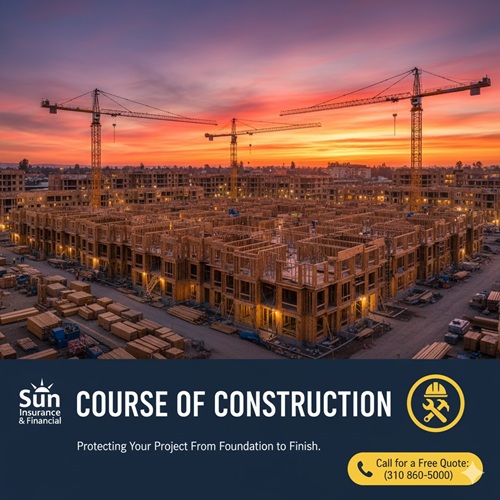
A: No, employee theft (or dishonest acts by any insured or subcontractor) is typically excluded from a standard Course of Construction policy. This type of loss is classified as a “fidelity” or “crime” risk. To cover theft committed by internal parties, you would need to purchase a separate Commercial Crime Policy or add a Fidelity Endorsement to your broader commercial package. COC will cover theft by unrelated third-party criminals.
Q: What is the difference between “Hard Costs” and “Soft Costs” in coverage?
A:
- Hard Costs are the direct physical costs of construction: labor, materials, and permanent fixtures. Your central policy limit covers this.
- Soft Costs are indirect costs due to a delay from a covered loss (like a fire). This includes interest on construction loans, real estate taxes, additional permit fees, and the loss of anticipated rental income. Soft Costs coverage is an essential but often optional endorsement that must be explicitly added to your Course of Construction Insurance policy.
Q: If a project is finished early, can I cancel the policy and get a refund?
A: Yes, most Course of Construction Insurance policies are issued for a fixed term (e.g., 12 months) but are designed to be canceled when the project reaches the termination criteria (e.g., Certificate of Occupancy). The insurer typically calculates the unused portion of the premium and issues a pro rata refund to the policyholder.
Q: What is an “Installation Floater,” and is it better than COC?
A: An Installation Floater is similar to COC but is typically purchased by a subcontractor (like an HVAC or plumbing specialist) to cover their specific materials from the time they are loaded onto a truck until they are installed. It is not a replacement for Course of Construction Insurance. The COC policy covers the entire building; the Installation Floater covers only a small, specific portion of the materials and work done by a single sub-trade. For a whole project, the Course of Construction policy is necessary.
- Conclusion: Building Confidence Through Comprehensive Coverage
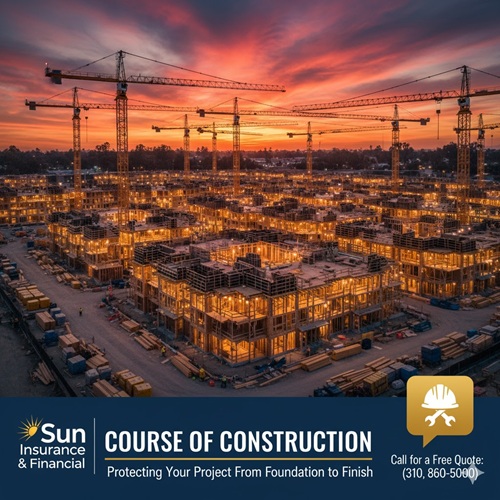
Course of Construction Insurance is more than just a piece of paper; it is the financial backbone of your construction investment. By protecting the structure, materials, and temporary installations from the myriad of perils inherent in a dynamic construction environment, this specialized insurance coverage allows owners and contractors to focus on quality and schedule, rather than potential catastrophe.
In an industry where risks are abundant and financial stakes are high, understanding the nuances of Course of Construction Insurance is not optional—it is a mandatory step in effective risk management. Ensure your next project is protected from its earliest days with a tailored, robust policy.
For expert guidance on your Course of Construction Insurance coverage needs, contact the specialists at Sun Insurance and Financial at (310) 860-5000. Build boldly, knowing your investment is secure. 🧱🛡️☀️
Sun Insurance and Financial https://SunInsurance.us
Travelers Insurance
The Hartford Insurance
California Fair Plan Insurance
Hiscox Insurance

